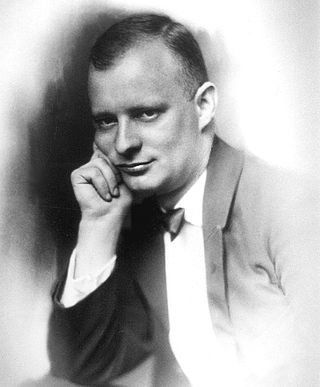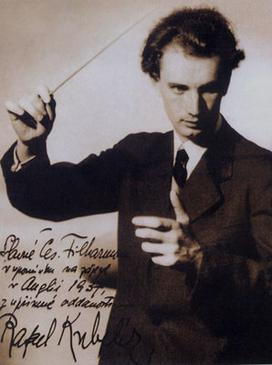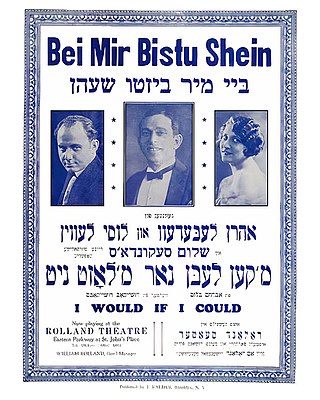
Karl Amadeus Hartmann was a German composer. A major figure of the musical life of post-war Germany, he has been described as the greatest German symphonist of the 20th century.

Kurt Julian Weill was a German-born American composer active from the 1920s in his native country, and in his later years in the United States. He was a leading composer for the stage who was best known for his fruitful collaborations with Bertolt Brecht. With Brecht, he developed productions such as his best-known work, The Threepenny Opera, which included the ballad "Mack the Knife". Weill held the ideal of writing music that served a socially useful purpose, Gebrauchsmusik. He also wrote several works for the concert hall and a number of works on Jewish themes. He became a United States citizen in 1943.

Richard Georg Strauss was a German composer and conductor best known for his tone poems and operas. Considered a leading composer of the late Romantic and early modern eras, he has been described as a successor of Richard Wagner and Franz Liszt. Along with Gustav Mahler, he represents the late flowering of German Romanticism, in which pioneering subtleties of orchestration are combined with an advanced harmonic style.

Paul Hindemith was a German and American composer, music theorist, teacher, violist and conductor. He founded the Amar Quartet in 1921, touring extensively in Europe. As a composer, he became a major advocate of the Neue Sachlichkeit style of music in the 1920s, with compositions such as Kammermusik, including works with viola and viola d'amore as solo instruments in a neo-Bachian spirit. Other notable compositions include his song cycle Das Marienleben (1923), Der Schwanendreher for viola and orchestra (1935), the opera Mathis der Maler (1938), the Symphonic Metamorphosis of Themes by Carl Maria von Weber (1943), and the oratorio When Lilacs Last in the Dooryard Bloom'd (1946), a requiem based on Walt Whitman's poem. Hindemith and his wife emigrated to Switzerland and the United States ahead of World War II, after worsening difficulties with the Nazi German regime. In his later years, he conducted and recorded much of his own music.

Gustav Heinrich Ernst Martin Wilhelm Furtwängler was a German conductor and composer. He is regarded as one of the greatest symphonic and operatic conductors of the 20th century. He was a major influence for many later conductors, and his name is often mentioned when discussing their interpretative styles.

Bruno Walter was a German-born conductor, pianist, and composer. Born in Berlin, he escaped Nazi Germany in 1933, was naturalised as a French citizen in 1938, and settled in the United States in 1939. He worked closely with Gustav Mahler, whose music he helped to establish in the repertory, held major positions with the Leipzig Gewandhaus Orchestra, New York Philharmonic, Concertgebouw Orchestra, Salzburg Festival, Vienna State Opera, Bavarian State Opera, Staatsoper Unter den Linden and Deutsche Oper Berlin, among others, made recordings of historical and artistic significance, and is widely considered to be one of the great conductors of the 20th century.

Herbert von Karajan was an Austrian conductor. He was principal conductor of the Berlin Philharmonic for 34 years. During the Nazi era, he debuted at the Salzburg Festival, with the Vienna Philharmonic, the Berlin Philharmonic, and during World War II he conducted at the Berlin State Opera. Generally regarded as one of the greatest conductors of the 20th century, he was a controversial but dominant figure in European classical music from the mid-1950s until his death. Part of the reason for this was the large number of recordings he made and their prominence during his lifetime. By one estimate, he sold an estimated 200 million records.

Rafael Jeroným Kubelík, KBE was a Czech conductor and composer.

Dmitri Shostakovich's Symphony No. 7 in C major, Op. 60, nicknamed the Leningrad Symphony, was begun in Leningrad, completed in the city of Samara in December 1941, and premiered in that city on March 5, 1942. At first dedicated to Lenin, it was eventually submitted in honor of the besieged city of Leningrad, where it was first played under dire circumstances on August 9, 1942, nearly a year into the siege by German forces.

The "Horst-Wessel-Lied", also known by its incipit "Die Fahne hoch", was the anthem of the Nazi Party (NSDAP) from 1930 to 1945. From 1933 to 1945, the Nazis made it the co-national anthem of Germany, along with the first stanza of the "Deutschlandlied".
Charlie and his Orchestra were a Nazi-sponsored German propaganda swing band. Jazz music styles were seen by Nazi authorities as rebellious but, ironically, propaganda minister Joseph Goebbels conceived of using the style in shortwave radio broadcasts aimed initially at the United Kingdom, and later the United States, after the German declaration of war on 11 December 1941.

"Bei Mir Bistu Shein" is a popular Yiddish song written by lyricist Jacob Jacobs and composer Sholom Secunda for a 1932 Yiddish language comedy musical, I Would If I Could, which closed after one season at the Parkway Theatre in Brooklyn, New York City. The score for the song transcribed the Yiddish title as "Bay Mir Bistu Sheyn". The original Yiddish version of the song is a dialogue between two lovers. Five years after its 1932 composition, English lyrics were written for the tune by Sammy Cahn and Saul Chaplin, and the English version of the song became a worldwide hit when recorded by The Andrews Sisters under a Germanized spelling of the title, "Bei mir bist du schön", in November 1937.

Fritz Busch was a German conductor.

Hans Schmidt-Isserstedt was a German conductor and composer. After studying at several music academies, he worked in German opera houses between 1923 and 1945, first as a répétiteur and then in increasingly senior conducting posts, ending as Generalmusikdirektor of the Deutsche Oper Berlin.
An overview of the evolution of Jazz music in Germany reveals that the development of jazz in Germany and its public notice differ from the "motherland" of jazz, the US, in several respects.
Karl Emil Heinrich Schwedler, also known as Charlie Schwedler was a singer and leader of the Nazi propaganda jazz band Charlie and His Orchestra during World War II. He was born in Duisburg, Germany.

American music during World War II was considered to be popular music that was enjoyed during the late 1930s through the mid-1940s.

Music in Nazi Germany, like all cultural activities in the regime, was controlled and "co-ordinated" (Gleichschaltung) by various entities of the state and the Nazi Party, with Propaganda Minister Joseph Goebbels and the prominent Nazi theorist Alfred Rosenberg playing leading – and competing – roles. The primary concerns of these organizations was to exclude Jewish composers and musicians from publishing and performing music, and to prevent the public exhibition of music considered to be "Jewish", "anti-German", or otherwise "degenerate", while at the same time promoting the work of favored "Germanic" composers, such as Richard Wagner, Ludwig van Beethoven and Anton Bruckner. These works were believed to be positive contributions to the Volksgemeinschaft, or German folk community.

Dmitri Shostakovich's Symphony No. 7 had its Leningrad première on 9 August 1942 during the Second World War, while the city was under siege by the Nazi German forces.

The Seventh Army Symphony Orchestra was the only symphonic orchestral ensemble ever created under the supervision of the United States Army. Founded by the composer Samuel Adler, its members participated in the cultural diplomacy initiatives of the United States in an effort to demonstrate the shared cultural heritage of the United States, its European allies and the vanquished countries of Europe during the post World War II era.

















